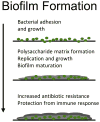Scaffold-based anti-infection strategies in bone repair
- PMID: 25476163
- PMCID: PMC4380521
- DOI: 10.1007/s10439-014-1205-3
Scaffold-based anti-infection strategies in bone repair
Abstract
Bone fractures and non-union defects often require surgical intervention where biomaterials are used to correct the defect, and approximately 10% of these procedures are compromised by bacterial infection. Currently, treatment options are limited to sustained, high doses of antibiotics and surgical debridement of affected tissue, leaving a significant, unmet need for the development of therapies to combat device-associated biofilm and infections. Engineering implants to prevent infection is a desirable material characteristic. Tissue engineered scaffolds for bone repair provide a means to both regenerate bone and serve as a base for adding antimicrobial agents. Incorporating anti-infection properties into regenerative medicine therapies could improve clinical outcomes and reduce the morbidity and mortality associated with biomaterial implant-associated infections. This review focuses on current animal models and technologies available to assess bone repair in the context of infection, antimicrobial agents to fight infection, the current state of antimicrobial scaffolds, and future directions in the field.
Figures



References
-
- Adams CS, Antoci V, Jr, Harrison G, Patal P, Freeman TA, Shapiro IM, Parvizi J, Hickok NJ, Radin S, Ducheyne P. Controlled release of vancomycin from thin sol-gel films on implant surfaces successfully controls osteomyelitis. J Orthop Res. 2009;27:701–709. - PubMed
-
- Afacan NJ, Yeung AT, Pena OM, Hancock RE. Therapeutic potential of host defense peptides in antibiotic-resistant infections. Curr Pharm Des. 2012;18:807–819. - PubMed
-
- Alarcon EI, Udekwu K, Skog M, Pacioni NL, Stamplecoskie KG, Gonzalez-Bejar M, Polisetti N, Wickham A, Richter-Dahlfors A, Griffith M, Scaiano JC. The biocompatibility and antibacterial properties of collagen-stabilized, photochemically prepared silver nanoparticles. Biomaterials. 2012;33:4947–4956. - PubMed
-
- AshaRani PV, Low Kah Mun G, Hande MP, Valiyaveettil S. Cytotoxicity and genotoxicity of silver nanoparticles in human cells. ACS Nano. 2009;3:279–290. - PubMed
Publication types
MeSH terms
Substances
Grants and funding
LinkOut - more resources
Full Text Sources
Other Literature Sources
Medical

